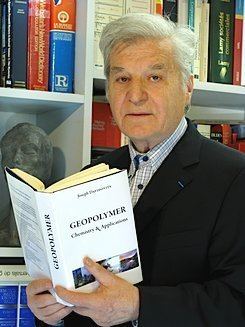Name Joseph Davidovits | Role Author | |
 | ||
Books The Pyramids: An Enigm, Geopolymer Chemistry and Appli, Why the Pharaohs Built the, They Built the Pyramids, Amenhotep - Joseph and Shel | ||
7 questions joseph davidovits sur la bible le patriarche joseph et mo se
Joseph Davidovits (born 23 March 1935) is a French materials scientist known for the invention of geopolymer chemistry. He posited that the blocks of the Great Pyramid are not carved stone but mostly a form of limestone concrete or man-made stone. He holds the Ordre National du Mérite, is the author and co-author of hundreds of scientific papers and conferences reports, and holds more than fifty patents.
Contents
- 7 questions joseph davidovits sur la bible le patriarche joseph et mo se
- Joseph Davidovits PhD Great Pyramid Artificial pyramid stone
- Career
- Archaeological theories
- References

Joseph Davidovits, Ph.D. (Great Pyramid: Artificial pyramid stone?)
Career

Davidovits obtained a Diplôme d'Ingénieur in chemical engineering from Ecole Nationale Supérieure de Chimie, Rennes, France in 1958, and a Dr. rer. nat. in macromolecular chemistry (PhD) from University of Mainz, Germany in 1960. Between 1962 and 1972, he researched in organic polymers for the textile industry in France. In 1964, he received Annual Award from the French Textile Chemical Society for his work on linear organic polymers.
In the aftermath of various catastrophic fires in 1970 in France involving flammable organic plastics, he decided to carry out research into new heat-resistant materials in 1972. The French private research company Cordi (SA) (called later Cordi-Géopolymère SARL), a family owned company, was also created. All publications related to the research from 1972 to 1979 on alumino-silicate solid-state chemistry are pertaining to the patent literature.
The geopolymer concept was created and published in 1979, together with the foundation of the non-profit organization Geopolymer Institute. In 1983, he was appointed as the Adjunct Professor of Chemistry at Barry University, Miami, Florida, and there he founded the Institute for Applied Archaeological Sciences (IAPAS) to study worthwhile ancient technology and advance the clarity of ancient history. Between 1983 and 1989, in collaboration with Lone Star Industries of the United States, a geopolymer cement called PYRAMENT and associated cement blends were developed.
The National Association for Science, Technology and Society (NASTS) and the Federation of Materials Societies, USA, awarded him the Gold Ribbon Award in 1994.
He is the president of Geopolymer Institute, chair of the annual conference Geopolymer Camp, and an active member of several scientific societies including American Chemical Society, American Ceramic Society, American Concrete Institute, New York Academy of Sciences and International Association of Egyptologists.
Archaeological theories
Davidovits was not convinced that the ancient Egyptians possessed the tools or technology to carve and haul the huge (2.5 to 15 ton) limestone blocks that made up the Great Pyramid. Davidovits suggested that the blocks were molded in place by using a form of limestone concrete. According to his theory, a soft limestone with a high kaolinite content was quarried in the wadi on the south of the Giza plateau. It was then dissolved in large, Nile-fed pools until it became a watery slurry. Lime (found in the ash of ancient cooking fires) and natron (also used by Egyptians in mummification) was mixed in. The pools were then left to evaporate, leaving behind a moist, clay-like mixture. This wet "concrete" would be carried to the construction site where it would be packed into reusable wooden molds. In the next few days the mixture would undergo a chemical hydration reaction similar to the setting of cement.
Using Davidovits' theory, no large gangs would be needed to haul blocks and no huge and unwieldy ramps would be needed to transport the blocks up the side of the pyramid.
Although his ideas are not accepted by mainstream Egyptologists, in December 2006 Michel Barsoum, Adrish Ganguly, and Gilles Hug published a peer-reviewed paper in the Journal of the American Ceramic Society stating that parts of the pyramid were cast with a type of limestone concrete. However, Dipayan Jana, a petrographer, made a presentation to the ICMA (International Cement Microscopy Association) in 2007 and gave a paper in which he concludes "we are far from accepting even as a remote possibility of a 'manmade' origin of pyramid stones."
